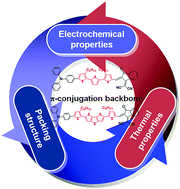Effect of the π-linker on the performance of organic photovoltaic devices based on push–pull D–π–A molecules†
Abstract
Two push–pull D–π–A molecules, 3T and DTT as donor materials, were synthesized and characterized for solution-processed bulk heterojunction (BHJ) organic photovoltaic (OPV) devices. The π-linker plays a vital role not only in electrochemical and thermal properties but also affects the thin film morphology of 3T and DTT. 3T showed the high electrochemical stability with a faster electrode reaction rate. The solution-processed OPV devices based on 3T showed higher power conversion efficiencies than DTT-based devices because of its superior electrochemical properties.



 Please wait while we load your content...
Please wait while we load your content...